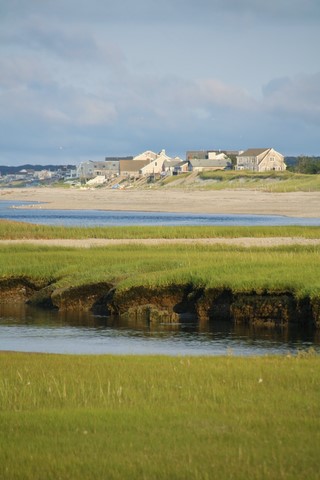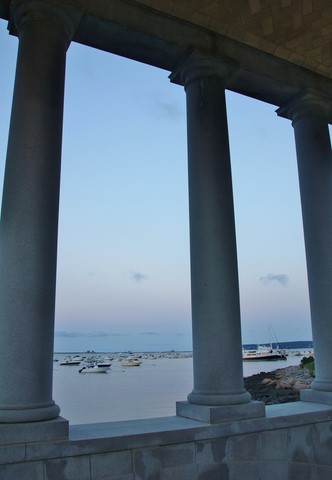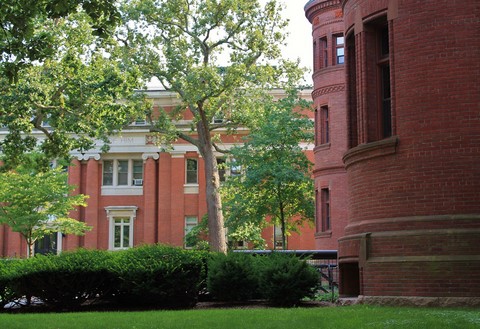Massachusetts - Sandwich, Plymouth & Cambridge
You can click on pictures to enlarge them
Sandwich
Between New-York and Boston, we made a stop in that lovely seaside resort. Founded in 1637, it is the oldest town in Cape Cod, wide peninsula composed of long wild beaches and fishing-villages that are much prized by the Bostonian and people from more distant lands. It thrived thanks to farming, fishing and trade, then later thanks to various industries. Nowadays, it lives essentially on tourism. It was the site of a Quaker establishment, and even though some of them left town because of religious strife, it still hosts the oldest Quaker meeting in the country.
It is located at the entrance of the bay. Its northern tip – where stands Scusset Beach State Reservation – is separated from the rest of the town by the Cape Cod Canal. It includes Shawme-Crowell National Forest, mainly composed of pine trees and oak trees, along with hills and small ponds.
Sandwich is known for its famous glass factory that opened in the 19th century, as well as its shops, art galleries, antique dealers and booksellers. It enjoys many attractions, notably its museums and its gardens. Hoxie House is the oldest house in Cape Cod. Globally, the town abounds in historic homes. As for the Dexter Grist Mill, it is the oldest mill in the peninsula. The more the 400 meters long boardwalk starts in the town center and runs over a marsh area to reach Town Neck Beach (photo) in Cape Cod Bay. We took it to the beach, which - to our great surprise - was not much crowded in spite of the season and the sunny weather. We jumped into the bay and understood why almost nobody had a swim: the water there was really cold!
Plymouth
We made a second stop in that small port town that was a must-visit according to us: indeed, it is filled with history because William Bradford and the other Pilgrim Fathers disembarked precisely there on the Mayflower on November, 21st 1620 to escape from religious persecution.
So, the History of the U.S.A. really started in Plymouth. Besides, the Pilgrim Hall Museum traces the adventure of those 102 passengers. The Mayflower II, exact replica of the original boat, is normally docked to the port. Unfortunately, it was not there that day. A local came and explained to us that it had been brought to another port to be restored. When it is there, guides in period costumes make you visit it while telling you that extraordinary adventure that led many decades later to the birth a new nation.
Plimoth Plantation is a museum complex dedicated to the history of that first colony which came and settled on those lands. There too, guides wear period costumes and speak like in the 17th century. Hedge House Museum is a Federal style building that offers interesting temporary exhibitions. It is part of the historic houses in Plymouth, like Spooner House, one of the oldest buildings in the picturesque North Street. It belonged to the Spooner family between 1749 – year of its construction – and 1954. It includes nice Colonial style furniture. Plymouth Rock is the rock on which one of the colons would have set foot. Given its symbolic value, it was carefully preserved in various places, and it stands nowadays on the sea front, on the place where the Pilgrim Fathers are supposed to have disembarked. It is sheltered by a small building with columns inspired by Greek temples (photo), and the number «1620» was carved in.
We lingered on that side so that we immerse ourselves in that defining moment of the American history, and then we enjoyed a delicious lobster in a restaurant, specialty of the region. Moreover, be aware that it is cheaper than in France, and so it is an excellent opportunity for those of you who are fond of that famous crustacean. As a starter, we had some clam chowder, typical dish from New-England. Then we took a nighttime walk on the port and the sea front, enjoying the very sweet and pleasant summer atmosphere before we leave for Boston.
Cambridge
On our second day in Boston, we spent a few hours in the afternoon in that city located on the north shore of the Charles River. We were keen on visiting the Harvard campus. Indeed, being so close to the most prestigious university in the country without discovering it seemed inconceivable to us. In spite of the presence of that elitist establishment, Cambridge can be relaxed, and it immediately feels like a very pleasant town, and festive as well. Concert halls, night clubs, cafés and trendy restaurants are numerous, especially around Harvard Square.
Harvard University (photo) was founded in 1636. Its campus is much extended and includes many red brick buildings. The thick ivy that clings to it in places gives it an additional charm. Harvard Yard is its nerve center, the meeting point of students and visitors, but above it all, the graduation ceremony takes place there. Buildings from the 18th century that surround the wide shaded lawn are remarkable, notably the Massachusetts Hall, the oldest in the campus (1720). However, the main attraction is obviously the Statue of the Founder John Harvard, which dates from 1884. The Widerner Library, Neo-Classic building from 1915, houses 80 kilometers of shelves filled with books! Opposite rises the splendid Memorial Church, which proudly displays its impressive portico with four columns. Its polychrome architecture is much refined, which makes it one of the most beautiful buildings in the campus. In addition to religious services, concerts take place there, notably chorals. As for the magnificent Memorial Hall, it is Victorian-Gothic style and also enjoys a breathtaking polychrome architecture. Colossal, it has very nice stained-glass windows and a superb tower with a clock. Its interior decoration includes remarkable materials as marble and cherry-walnut paneling.
Harvard Arts Museum is a complex of three renowned art museums: Fogg Art Museum, Arthur M. Sackler Museum and Busch-Reisinger Museum. Nearby, the Carpenter Center for the Visual Arts – that is owed to Le Corbusier – houses a school of visual arts, an exhibitions gallery and a movie theater.
As for the Harvard Museum of Natural History complex, it includes the Harvard University Herbaria, the Museum of Comparative Zoology and the Mineralogical & Geological Museum. Nearby stands the Peabody Museum of Archaeology and Ethnology, which houses remarkable Mayan and Aztec pieces.
Visiting that prestigious establishment was as pleasant as instructive, and we left it with a sense of pride to stroll a few minutes in the streets of Cambridge, to immerse ourselves with its casual atmosphere in the summer mildness. We stopped for a moment at a small shaded park to attend the performance of amateur musicians, ideal prelude to the great rock show that was coming for us in Boston to end with a flourish.
Published on January, 4th 2019






